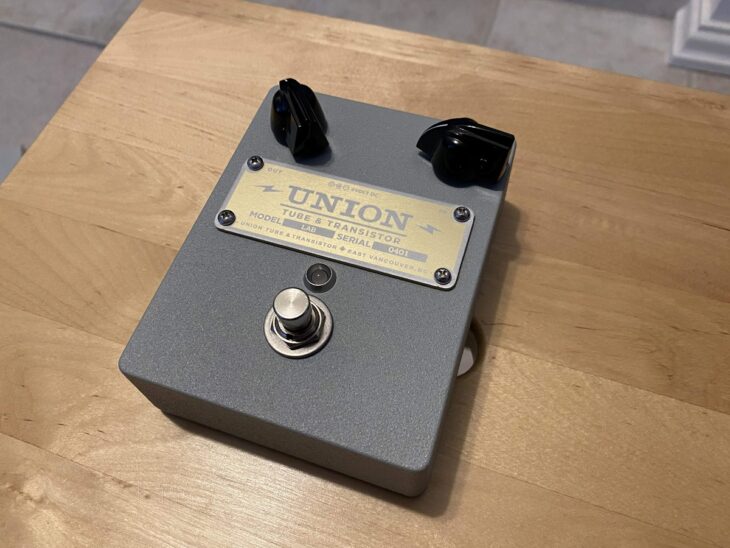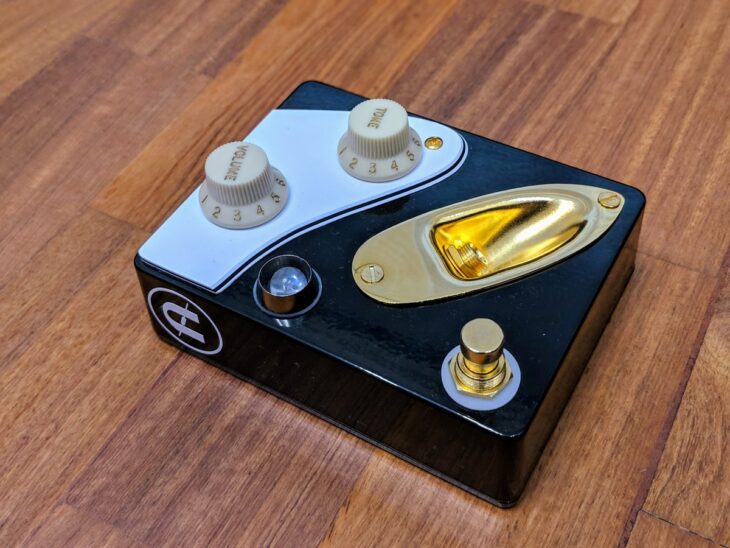Ever since he formed the White Stripes at the very end of the 20th century, Jack White has been trying to push the sonic boundaries of the world. Yet, what once was a retro fever trying to mimic the aesthetics and sounds of the original blues players has morphed into a retro-futuristic, unique voice that moved an entire generation.
We could consider Jack White III a real Renaissance man, being a producer, drummer, guitarist, singer, upholsterer, entrepreneur, businessman, music lover, and the list could go on.
Lately, his aim has been redirected to the guitar pedal world and his creations are as unique as he is. But, beyond the aesthetics and revolutionary concepts, is TMR guitar gear any good?
Table of Contents
From Rockstar to Businessman
The White Stripes arrived on the music scene to change it completely and forever. This scorching-hot rocking duo became a trademark sound and armed with hits like “Seven Nation Army” and some covers like “I Just Don’t Know What to Do with Myself” took over the world.
Soon after, many duos became mainstream acts (like the Black Keys, for example) and the fuzzed-out, take-no-prisoners sound of the guitar became a common thing among radio-ready bands.
But Jack White is a renaissance man, and as such, he can’t stay still. So, besides having three successful bands (his solo project, The Raconteurs, and The Dead Weather where he plays drums), he also founded a record label, memorabilia shop, live venue, vinyl pressing plant, and guitar gear brand called Third Man Records.
He even had time to enter the Guinness Book of Records for the world’s fastest record!
Jack White’s Unique Taste n’ Sound
Before we jump right into the guitar gear, there’s one statement that needs to be made. Jack White didn’t climb to the top of the charts or remain relevant for almost three decades for being a copycat of anything that came before him.
He’s made originality his biggest asset. You just never know what the man is going to come up with next, because he’s not only unpredictable but also very prolific. He’s always trying to stretch the limits, challenge the boundaries, and surprise people with his unique vision of the world.
That’s what Third Man’s guitar gear is all about; uncanny sounds that might be inspiring and interesting but that remain outside the clichés of the modern world.
Here’s Jack White III explaining his approach and the genesis of each pedal.
TMR Guitar Gear
Bumble Buzz
The Bumble Buzz is the first pedal that TMR released in 2013. It is a collaboration between TMR and the company Union Tube & Transistor from Vancouver.

It is a one-way ticket to doomsday. There are no knobs, switches, or any other selector to turn the volume, the dirt, or the octave down. It is also built like a tank, with the streamlined, almost Spartan circuit inside a rugged metal housing that’s ready for crowd surfing and sweaty rocking shows.
The one thing that hits you right away with this pedal is that it’s a complete head-turner. Yes, the moment you engage it, everybody in the room will turn and watch what you’re doing because this pedal does sound like a one-of-a-kind octave fuzz.
The downside is that you can’t use it not to sound like Jack, it’s like a White-in-a-box pedal. Therefore, you might come across as a copycat of the real thing. That said, if you keep riffs slow and short, and don’t play more than two strings at once, you’ll be in octave fuzz heaven.
This pedal sounds round, rich, and menacing, and has plenty of rocking tones to offer bold players who are not afraid to stand out from the crowd.
If you’re a JWIII fan, this is a must-try. If you’re not, it’s worth the try.
Triplegraph
Let me tell you that I had never seen a pedal quite like the Triplegraph. I’m not talking just from a visual point of view, which is most evident. But I’m also talking from a sound and functionality point of view. It’s something only the minds of Jack White III and Coppersound Pedals could have seen and made.

To begin with, you’re stepping on a telegraph machine. Well, not one but three. Secondly, the big base is very rugged and entirely made of metal taking up hefty real estate on your pedalboard. Finally, it’s finished in either yellow or black with all kinds of Art-Deco ornaments making it a work of art.
But what does this pedal do? Well, the left telegraph machine works as an octave down, the right one as an octave up, and the middle is a kill switch that doubles as a momentary effects loop.
All three switches can be used momentarily or can be latched down. So, for example, you can leave either of the octaves on and use the effects loop to bring in your favorite fuzz. Then, as you play, with both octaves on, the guitar can be clean and you can use the middle telegraph switch to bring the fuzz in and out.
Is it a simple pedal to use? The answer is no. Will it take you to explore new sonic territories? The answer is definitely yes.
Plasma Coil
I had never plugged my guitar into anything as complex as this pedal. The idea is that it turns your guitar’s signal into 3500 volts. This burst of energy is then discharged straight into a xenon gas tube. After going through that process, the guitar’s signal is translated back into audio.
After that processing, the bandwidth of the original audio is much wider and it’s met with 6 modes as well as other tone-tweaking knobs.
The most amazing part of it all is that the xenon tube is right in sight, therefore, you can literally see your guitar’s signal exciting the gas in real time. This all-analog circuit comes directly from Latvia.
The pedal is controlled by five knobs. The top two handle Voltage (gain) and Volume. The bottom two knobs handle the low and high frequencies like an EQ. The knob in the middle allows you to go through six modes that turn the guitar into an 8-bit, glitchy instrument, a massive low-end monster, or a giant mosquito attack.
The pedal has two switches to engage the effect and to add a boost to the signal. These can be used as latches or momentary switches.
As you would expect, this pedal sounds like nothing you’ve heard before in a very Jack White vibe giving you a ton of different tones to play with but with a big reminiscence to the sound of the Third Man Records founder.
Is it everybody’s cup of tea? Probably not. Will it make your guitar go wild and have you playing and having fun for a month? You can bet on that.
Flex
The Flex is a Mantic Effects creation. What it does is recreate the unpredictable wonders of a PLL unit. PLL states for Phase-Locked Loop, which is an attempt to stabilize a signal.
Well, this pedal utilizes that technology within the circuit of a synth fuzz that transforms the guitar’s signal into a plethora of different noises, phaser whooshes, squawks, theremin-like sounds, and brutal bit-crushed fuzzed-out octave sounds.
You can hear it in full splendor in Jack White’s song “Why Walk a Dog?”
To be completely honest, the unpredictability of the effect and the enigmatic controls left me quite puzzled and it was hard to get “usable” sounds from this noisemaker. What I do have to say is that a fun thing that starts happening is that you somehow start playing to the pedal as if it were a fellow band member. Trying to make it react the way you want it when you want it.
The results for me were a fun, completely wild mayhem I enjoyed quite a bit. That said, this is, perhaps, the most difficult pedal in the series to blend in with your current guitar setup.
Double-Down Pedal
The latest addition to the TMR pedal line (for now) is a collaboration with the pedal giants MXR. The whole idea behind this pedal was to recreate the MXR Micro Amp that Jack White used throughout the time he was with the White Stripes to boost the signal.
But, as you know by now, Jack doesn’t do anything without a twist. So, he crammed two preamp circuits within the same pedal and gave them not only separate outputs (that create a true stereo image) but also individual gain per channel to drive, for example, two different amps.
This is a marvelous product, it’s like having an ABY box on steroids with the ability to maneuver each channel’s volume separately.
You might be scratching the top of your head with a pic and going “What do I need such a thing for?”. Well, one of the many things you can do is create a wet/dry signal path boosting whichever side you want.
For example, I tried this by going into a Big Muff, a Carbon Copy, and a Phase 95 into my Sovtek MIG-50 with OUT 1 and straight into my Deluxe Reverb with OUT 2. This way, I had that great distorted sound on one side and my clean guitar on the other making it all clearer and more understandable.
That’s only one of the ways to do it, there’s a plethora of scenarios you can use this pedal. Furthermore, it’s a great studio and stage tool to take on your backpack just in case you can convince the bass player of the other band to let you hook your pedalboard to his amp too.
Is TMR Guitar Gear Any Good?
Alright, so, let me try to answer the initial question. I’ll do this with some bullet points so you can understand my point of view a little better.
- Construction & Dependability – Construction-wise, TMR was smart enough to join forces with some of the best pedal companies in the world. Therefore, each of the units in their catalog carries that same tested-and-true, road-worthy product legacy brands like MXR and Union Tube & Transistor have. I say, TMR guitar gear is built to last.
- Versatility & Features – This category is a little blurrier because the approach that TMR and each of the companies took for building these products is minimalist. Yes, instead of having dedicated knobs to change each of the parameters and being able to modify the pedal’s voicings, you have several unmodifiable sounds in clever layouts. Except for the Bumble Buzz, of course. I say that TMR pedals aren’t versatile, but they’re a lot of fun to play with.
- Sound & Tones – Here’s where it gets really interesting. I would say that TMR guitar gear is definitely a lineup of great-sounding pedals. I have no doubt that tone pursuit was the main quest the team behind these products was after. Will they suit your playing, guitar rig, or taste? Well, that’s something only you can answer. But if you like the tones Jack White became famous for throughout his career, there’s a lot you can do with these pedals to get closer to that audio. I say that TMR pedals have great audio quality, can deliver serious tones, and sound great in a very restricted, small sonic realm.
Happy (octave fuzz) playing!

